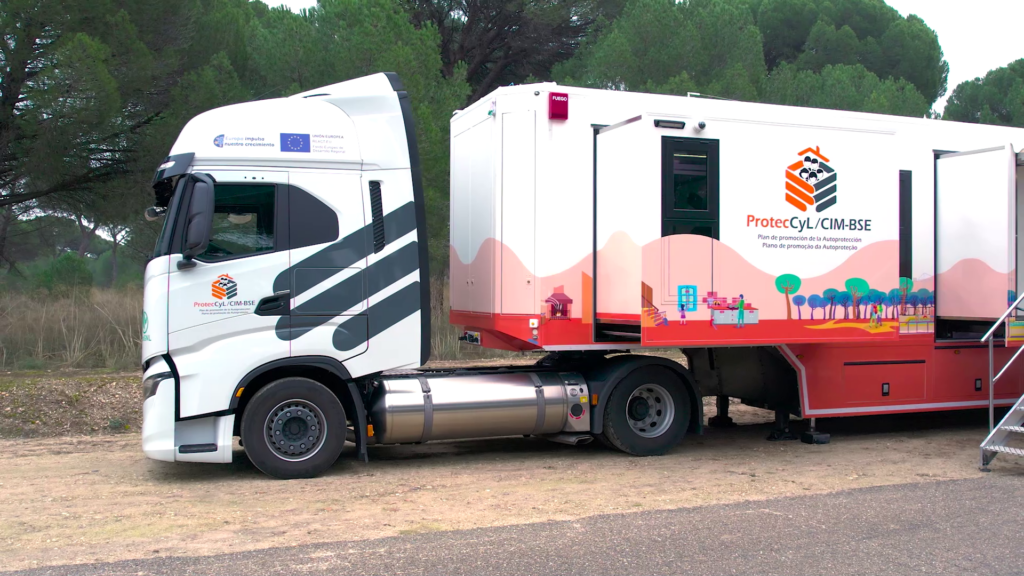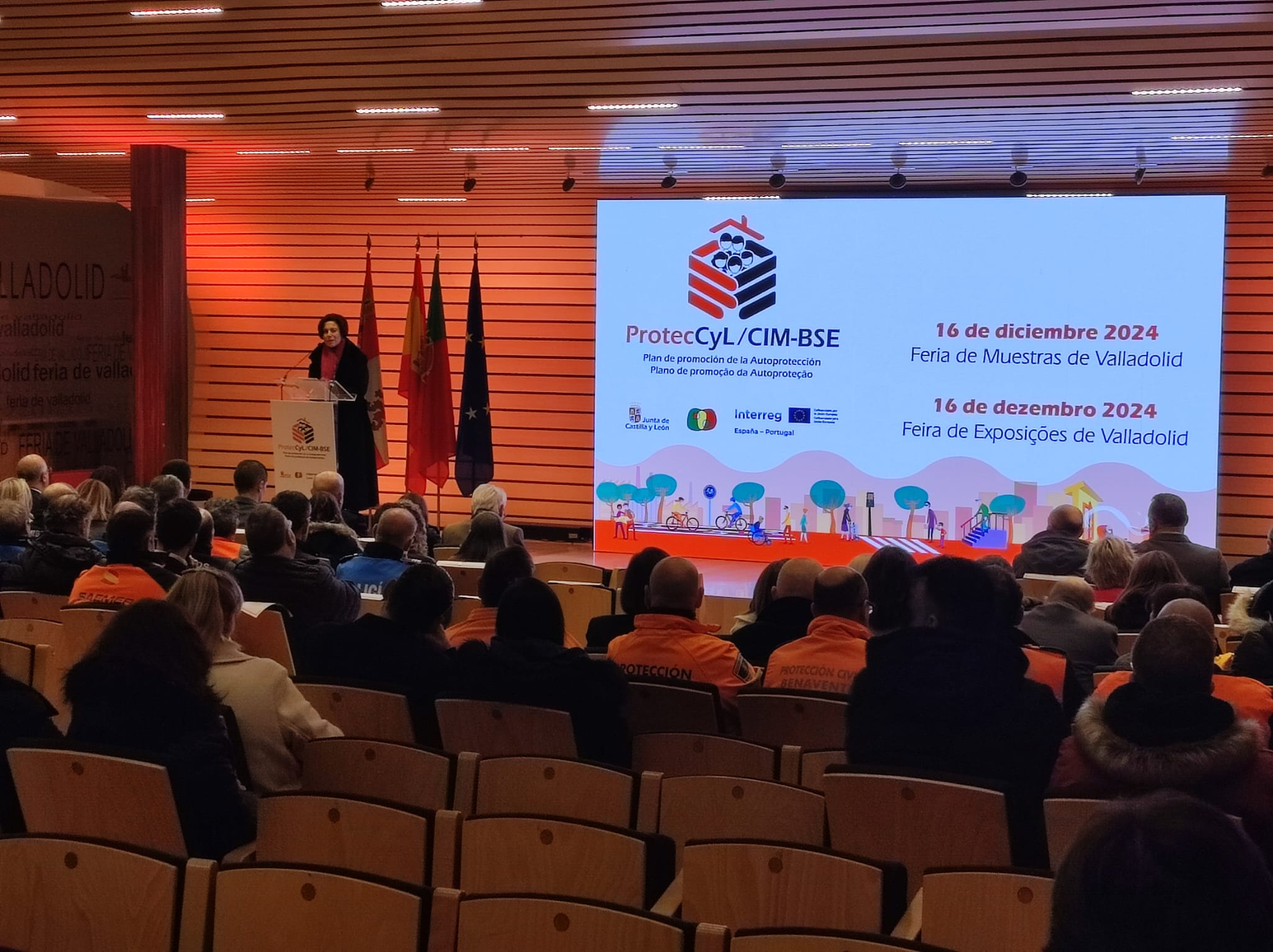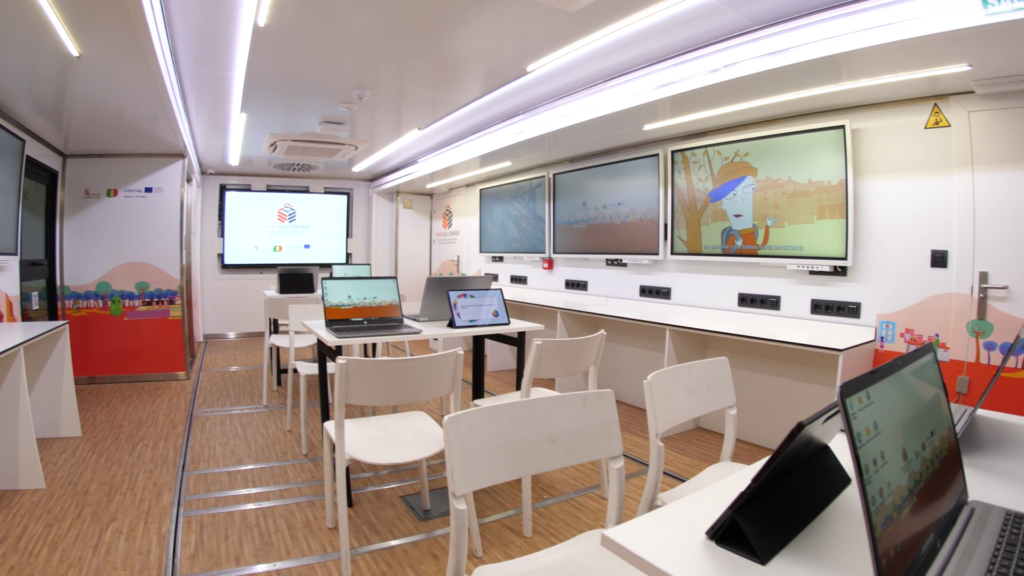On December 16, 2024, the Junta de Castilla y León presented the PROTECCYL/CIM-BSE programme, an itinerant initiative that, during 2025 and 2026, will tour the municipalities of Castilla y León and the fifteen towns in the Portuguese region CIM-BSE, with the aim of promoting a culture of self-protection.
This program is part of the PROCTEPGER_HORIZONTE_27 project, led by the Civil Protection and Emergency Agency. The Provincial Governments of Ávila, León, and Salamanca, the municipalities of León, Salamanca, and Zamora, as well as the Portuguese region CIM-BSE, which covers municipalities from the cross-border Beira Interior region, are partners in this initiative. PROCTEPGER_HORIZONTE_27 is a cross-border cooperation project co-financed by the European Union, through the Interreg VI A Spain-Portugal (POCTEP) 2021-2027 Programme, with a total budget of €12,744,892 over its three years of execution.
As part of the project, a large mobile unit will travel to hundreds of municipalities in Castilla y León and the fifteen towns of the Portuguese CIM-BSE region.
The event was inaugurated by the Minister for Environment, Housing, and Land Planning, and was attended by presidents of the provincial governments, mayors, and various authorities and civil protection leaders. During the ceremony, the European Commission’s representative, Delia Bonsingore, the Deputy Director-General for European Territorial Cooperation at the Ministry of Finance, Carmen Hernández, and the Director of the Joint Secretariat of the Interreg Spain-Portugal (POCTEP) Programme, Elena de Miguel, made speeches.
The European Commission representative, Delia Bonsingore, Programme Manager at DG Regio, addresses the audience via videoconference.
The Director of the Joint Secretariat of the Spain-Portugal Interreg Programme (POCTEP), Elena de Miguel, highlighted the importance of cross-border cooperation as an added value in projects co-financed through the programme.
Institutional authorities highlighted the alignment of the project with the European Union’s political objectives for the 2021-2027 period, focused on building a more resilient Europe, capable of mitigating and adapting to climate change, as well as preventing and managing risks. In this regard, the project has been classified as strategic and has received European funding of €9,558,669.
🗞️ El proyecto PROCTEPGER. HORIZONTE 27 de cooperación transfronteriza Interreg @poctep 🇪🇸🇵🇹🇪🇺 fortalece sistemas de protección civil de los territorios socios: colaboración frente a catástrofes
✔️Lidera la Agencia de Protección Civil y Emergencias de Castilla y León ✔️12,74 M€ pic.twitter.com/G0lmau7I4r— Fondos Europeos en España (@FondosUE_Esp) December 18, 2024
🇪🇸 🎤 “Hoy damos un paso importante hacia la autoprotección ciudadana.”
👉 Juan Carlos Suárez-Quiñones, Consejero de Medio Ambiente, abre el acto.#ProtecCyL @RegioInterreg @poctep @ProtecCyL_CIMBSE pic.twitter.com/QpO8VeJkHh— ProtecCyL/CIM-BSE (@ProtecCyl) December 16, 2024
Más de 12M€ para proteger a personas, bienes y #MedioAmbiente.
📺Directo: presentación del proyecto @ProtecCyl https://t.co/kEqB5XrucJ#POCTEP🇵🇹🇪🇸 #MadeWithInterreg @FondosUE_Esp pic.twitter.com/e03vmufK3C
— Interreg España-Portugal (@poctep) December 16, 2024
Regarding the project partners, both the Coordinator of the technical support structure of CIM-BSE and the Councillor for European Funds at the City Council of Zamora have emphasized the importance of participating in large-scale projects like this one to strengthen their civil protection systems.
Finally, executives from UTE HORIZONTE 27, the contractor for the PROTECCYL/CIM-BSE Plan, highlighted the significance of public-private collaboration in the execution of such public initiatives and expressed their enthusiasm, as experts with in-depth knowledge of the risks in the partner regions of the Project, to contribute their experience in promoting the culture of self-protection, a cause they firmly support as a company.
PROCTEPGER_HORIZONTE_27 Project
The PROCTEPGER_HORIZONTE_27 Project is a joint initiative led by the Civil Protection and Emergency Agency as the main partner, with additional partners including the Provincial Councils of Ávila, León, and Salamanca, the City Councils of León, Salamanca, and Zamora, and the Comunidade Intermunicipal das Beiras e Serra Estrela (CIM-BSE), a Portuguese region comprising the municipalities of Almeida, Belmonte, Celorico da Beira, Covilhã, Figueira de Castelo Rodrigo, Fornos de Algodres, Fundão, Guarda, Gouveia, Manteigas, Mêda, Pinhel, Sabugal, Seia, and Trancoso.
The Project is funded by the European Regional Development Fund (ERDF) through the Interreg VI A Spain-Portugal Cooperation Programme (POCTEP) 2021-2027, bringing the total public investment to €12,744,892, taking into account the contributions from the benefiting public entities.
🇵🇹 🌟 A quem se destina o #ProtecCyL/CIM-BSE?
1️⃣ Cidadãos: Autoproteção no dia a dia.
2️⃣ Empresas: Proteger o tecido empresarial.
3️⃣ Serviços: Reforço à Proteção Civil.
📍 Hoje em Valladolid.@RegioInterreg @poctep @ProtecCyL_CIMBSE pic.twitter.com/EeMDz9yiKV— ProtecCyL/CIM-BSE (@ProtecCyl) December 16, 2024
This is a strategy for the civil protection systems of the partner territories, with three lines of action referring to the basic components of civil protection: the population, which is segmented based on its relationship with risks; the human resources of the civil protection system: firefighters, local police, and civil protection volunteers, on whom actions are carried out to improve and update their knowledge and skills; and the prevention, fire extinguishing, and rescue services of the partner territories, as these services are the paradigm of the interterritorial collaboration principle that characterizes civil protection.
The goal of the Project, after its three years of implementation in 2024, 2025, and 2026, is to strengthen the civil protection systems of Castilla y León and the Portuguese CIM-BSE region, generating synergies and links that will be crucial in the event of having to manage an emergency jointly in any of these territories.
Cross-border Training
Regarding the training of firefighters, local police, and civil protection volunteers, the Civil Protection and Emergency Agency has organized up to ten cross-border courses in the last quarter of 2024, with an investment close to €490,000. Nearly 200 civil protection personnel, including firefighters, local police, and volunteers from Castilla y León and Portugal, have been able to put into practice what true cross-border collaboration means in emergencies and large-scale disasters through the simulation exercises organized.
As for the course topics, those for firefighters focused on their response to terrain movements causing structural collapses; the courses for local police focused on stabbings and knife attacks; and the courses for civil protection volunteers covered the relevant topics for this group.
Additionally, on December 3, 4, and 5, the final exercise and closure of this first cycle of cross-border training in 2024 took place in Zamora, with a traffic accident simulation. Firefighters, local police, volunteers, and medical personnel from Castilla y León and Portugal participated in this practical exercise.
Cross-border activities will continue in 2025 and 2026, with an investment surpassing €565,000.
Prevention, fire extinguishing, and rescue services
The second line of action of the Project refers to the improvement of prevention, fire extinguishing, and rescue services managed by the Project partners. The investments by local entities co-financed by the ERDF are distributed among the construction of fire stations, with the Provincial Council of Ávila building the Arenas de San Pedro fire station (cost of the project: €1,410,509) and the City Council of Zamora building the city’s fire station (cost of the project: €3,982,000); the acquisition of vehicles exclusively for use by firefighters, such as those by the Provincial Councils of León (cost of the project: €1,546,808) and Salamanca (cost of the project: €750,000) and the City Council of León (cost of the project: €1,046,834); and the acquisition of various equipment by the City Council of Salamanca (cost of the project: €950,000) and the Portuguese CIM-BSE region (cost of the project: €684,508).
Self-Protection Promotion Plan PROTECCYL/CIM-BSE
The action line that the PROCTEPGER_HORIZONTE_27 Project directs at the population of the partner territories is the PROTECCYL/CIM-BSE Self-Protection Promotion Plan, which aims to promote the culture of self-protection as a resource to enhance and train individuals’ abilities to prevent disasters from causing harm to people, property, and the environment.
The Regional Minister for Environment, Housing, and Land Planning emphasized that public initiatives of this kind are currently highly valued, especially in light of recent events in the Valencian Community and in many other countries, which make us aware that natural or anthropic risks are always latent, and when they materialize, they do so with increasing intensity.
The approach chosen for this awareness-raising task is a large mobile unit that, resembling a trailer, will tour hundreds of municipalities in Castilla y León and the fifteen towns of the Portuguese CIM-BSE region over the next two years.
The Regional Minister for Environment, Housing, and Land Planning highlighted ten key strengths of the Plan:
- The significant cross-border investment effort made by the European Union and Castilla y León, exceeding €1.7 million over its two years of development.
- PROTECCYL/CIM-BSE strengthens collaboration between the provinces of Castilla y León and between Castilla y León and Portugal in the prevention and management of natural or anthropic risks that are common to the partner territories, generating synergies and links that will be crucial in case of needing to manage a disaster in any of these areas.
- The Plan adds value in two of the three risk areas: prevention and management. The more is invested in emergency prevention and management, the less costly the third area, recovery, will be.
- The inclusive nature of the activities organized to promote the culture of self-protection, as the civil protection system should be inclusive—no one should be left out.
- The Plan is structured around three axes depending on the population segments its activities target: the general public, economic agents, and civil protection facilitators, because not everyone faces risks in the same way or generates the same type of risks.
- The Plan has a distinctly rural character. PROTECCYL/CIM-BSE brings the culture of self-protection directly to the doorsteps of the people of Castilla y León and Portugal in small municipalities, helping the local residents themselves build resilient communities to risks.
- The Plan addresses a variety of natural, anthropic, and technological risks from diverse perspectives.
- The resources used in the Plan are simple and clear, while also being innovative and an example of the application of the latest technologies in the service of self-protection.
- The activities of the Plan are led by specialists in risk analysis and management.
- The Plan generates beneficial effects for everyone, as the culture of self-protection has a multiplying effect.
All information about this itinerant Self-Protection Promotion Plan can be found on the website www.proteccyl.com and on its social media platforms on Instagram, X (formerly Twitter), and YouTube.
The presentation event concluded with a visit by the attendees to the interior of the PROTECCYL/CIM-BSE mobile unit, parked in the Valladolid Exhibition Center parking lot, where they were able to experience firsthand all the opportunities offered by the Programme in promoting the culture of self-protection.









